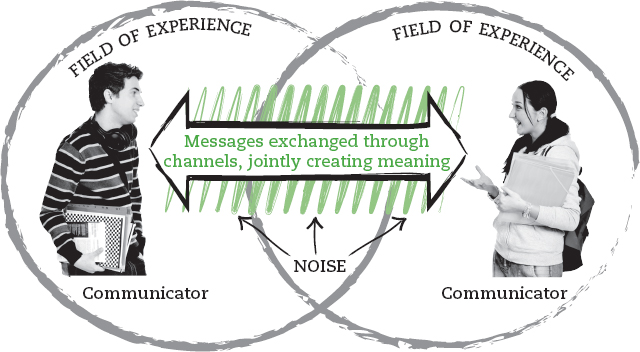Transactional Communication Model
The transactional communication model  (see Figure 1.4) suggests that communication is fundamentally multidirectional. That is, each participant equally influences the communication behavior of the other participants (Miller & Steinberg, 1975). From the transactional perspective, there are no “senders” or “receivers.” Instead, all the parties constantly exchange verbal and nonverbal messages and feedback, collaboratively creating meanings (Streek, 1980). This may be something as simple as a shared look between friends, or it may be an animated conversation among family members in which the people involved seem to know what the others are going to say before it’s said.
(see Figure 1.4) suggests that communication is fundamentally multidirectional. That is, each participant equally influences the communication behavior of the other participants (Miller & Steinberg, 1975). From the transactional perspective, there are no “senders” or “receivers.” Instead, all the parties constantly exchange verbal and nonverbal messages and feedback, collaboratively creating meanings (Streek, 1980). This may be something as simple as a shared look between friends, or it may be an animated conversation among family members in which the people involved seem to know what the others are going to say before it’s said.
These three models represent an evolution of thought regarding the nature of communication, from a relatively simplistic depiction of communication as a linear process to the view that communication is a complicated process that is mutually crafted. See Table 1.1 for more on each model.

Table 1.1 Communication Models
| Model | Examples | Strength | Weakness |
| Linear | Text and instant-messaging, e-mail, wall posts, scripted public speeches | Simple and straightforward | Doesn’t adequately describe most face-to-face or phone conversations |
| Interactive | Classroom instruction, group presentations, team/coworker meetings | Captures a broad variety of communication forms | Neglects the active role that receivers often play in constructing meanings |
| Transactions | Any encounter (most commonly face-to-face) in which you and others jointly create communication meaning | Intuitively captures what most people think of as interpersonal communication | Doesn’t apply to many forms of online communication, such as e-mail, Facebook posts, and text-messaging |
LearningCurve